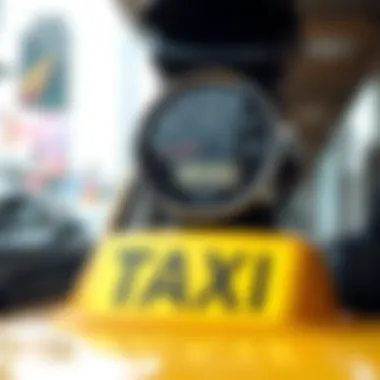Taxi Rates in Dubai: A Complete Guide


Intro
Navigating taxi services in Dubai is essential for both newcomers and long-term residents. The ease of getting around this bustling metropolis often hinges on understanding the intricacies of taxi rates. As one of the busiest regions in the world, Dubai's taxi system is an efficient mode of transport that offers both convenience and accessibility.
In this guide, we will break down the various facets of taxi rates, including the cost per kilometer, fare structures, and elements that contribute to the pricing. Also, we will touch upon the specific services available and provide useful tips to help you optimize your commuting budget. With this knowledge, whether you’re an expat, visitor, or local, you will navigate the city’s taxi landscape with confidence.
The goal here is to give you more than just numbers; we aim to equip you with a holistic understanding of what to expect when hailing a cab in the heart of the UAE. You might find that the taxi system here is more than just a means of transport; it's a glimpse into the vibrant culture and fast-paced life that Dubai has to offer.
So buckle up, as we dig deep into the world of Dubai's taxi rates.
Intro to Taxi Services in Dubai
When exploring a city as dynamic as Dubai, navigating its transportation options can be like trying to find a needle in a haystack. This is particularly true when it comes to understanding taxi services. Taxis in Dubai are not just a means of getting from point A to point B; they are woven into the very fabric of the city's transport landscape. In this section, we will dive into why grasping taxi rates is not just useful, but essential for both residents and visitors alike.
The Importance of Understanding Taxi Rates
Understanding taxi rates isn't just about knowing how much money to keep handy. It’s about knowing your options and making informed choices that align with your budget and trip needs. If you hop into a taxi with no idea of how the fares work, you might find yourself with a surprise bill you weren't prepared for. Let’s face it, nobody wants to experience sticker shock at the end of a ride.
Moreover, taxi rates can vary significantly depending on the time of day, the type of taxi, and additional charges that might be tacked on. By being aware of these rates, passengers can better manage their travel expenses, which is especially important for expats or investors who frequently travel in and out of the emirate. Having this knowledge allows you to plan more effectively, ensuring you can focus on other aspects of your journey, be it meetings, sightseeing, or leisure.
Overview of Dubai's Transportation Landscape
Dubai’s transport infrastructure is like a well-oiled machine, combining modern technology with the rich heritage of the region. Taxis play a pivotal role within this ecosystem, alongside the metro, buses, and even water transport.
The taxi services in Dubai are operated by a few primary companies like the Dubai Taxi Corporation and several private operators, providing a range of vehicles from standard rides to luxury options. In addition, the introduction of technology means that booking a taxi has never been simpler, be it through street hailing or using apps like Careem and Uber. With more than 2,000 taxis on the road, there's rarely a need to wait long for a ride.
The fares are regulated by the Road and Transport Authority of Dubai, ensuring consistency and fairness in pricing. As a result, a ride in Dubai can be a comfortable experience, offering not just convenience but also a glimpse into the city’s vibrant life.
In summary, understanding taxi services in Dubai presents a plethora of benefits. Familiarizing yourself with the taxi rates and how the broader transportation landscape operates can lead to richer and perhaps more economical experiences while exploring or conducting business in this thriving metropolis.
Taxi Rate Structure in Dubai
Understanding the taxi rate structure in Dubai is pivotal for anyone planning to navigate the city, be it for business, leisure, or daily commuting. Taxis are not just a means of transport; they embody the convenience and efficiency of traveling through an urban landscape. Being knowledgeable about how fares are calculated helps individuals make informed decisions, ultimately saving time and money.
The structure primarily revolves around two aspects: base fare and the cost per kilometer. However, additional fees can catch passengers unawares if not understood beforehand. When you step into a taxi, the meter starts ticking, but knowing exactly what each number contributes to your total fare enhances your journey's predictability.
Base Fare and Cost per Kilometer
The base fare acts as the starting point for every taxi ride. In Dubai, this base price isn't just a random figure; it reflects the service quality and the overall operating costs factored within. As of the current rates, this fee typically begins around 12 AED during the day, rising to 15 AED at night. It’s these initial charges that lay the groundwork for the overall fare calculation.
Following the base fare, the taxi meter displays a price per kilometer traveled. This charge varies slightly depending on the taxi type and time of day. A standard taxi typically incurs a rate of about 1.82 AED per kilometer during daytime and may increase during late-night trips due to demand.
In calculating fares, a simple rule of thumb serves well: the longer the distance, the higher the total fare reaches. This linear relationship helps in establishing reasonable expectations about what you might spend on either short hops across town or more extended voyages across the sprawling cityscape.
Additional Fees and Charges
While the base fare and cost per kilometer may seem straightforward, additional fees can complicate the fare structure. Being aware of these extra charges can spare passengers the shock of a hefty bill at the end of their ride.
Airport Pickup Charges
Consider the airport pickup charge, which typically adds another layer to your fair equation. It serves as a fee that is specifically applied when a taxi is hailed at Dubai International Airport. This charge often hovers around 25 AED, reflecting the premium service provided in this scenario. The underlying benefit of this fee is the assurance of a remorseless, convenient ride to your accommodation or destination from the busy airport. Given the usually high rush of travelers, having a designated taxi right at hand can save one from the lengthy wait times associated with other transport modes.
Night Surcharge
Next comes the night surcharge, an element designed to adjust for the later hours’ higher demand. Reflecting the hustle and bustle of Dubai's nightlife, this charge applies during certain hours—typically from 12 AM to 6 AM. A higher fare during these periods, which can see rates climb to 1.90 AED per kilometer, should be anticipated for those planning late-night movements around the city. This surcharge ensures that taxi services remain reliable even when others may fall short.
Booking Fees
Last but not least, booking fees come into play, especially for those favoring convenience over traditional street hailing. When requesting a taxi via a booking app or phone service, a fee of about 5 AED may seem nominal compared to the luxury of having a vehicle dispatched right to your location. Utilizing modern booking tools often allows for more efficient ride planning, effectively managing passenger flow and taxi availability during busy periods. However, it’s crucial to factor in this added fee when calculating overall transportation costs.
In summary, mastering the taxi rate structure in Dubai not only ensures efficient budgeting but enriches the travel experience, allowing for better planning and fewer surprises along the way.


Types of Taxis Available in Dubai
When navigating the streets of Dubai, understanding the various taxi options available can make a significant difference in your travel experience. The diversity in taxi services reflects the city's aim to cater to the varied needs of both residents and visitors. From standard fares to luxury car rides, knowing what’s at your disposal will lead to informed choices and budget-friendly trips. It’s crucial to weigh the benefits and service levels of each type of taxi while considering factors such as comfort, pricing, and convenience.
Standard Taxis
Standard Taxis present the most common and accessible form of taxi service in Dubai. Characterized by their distinctive yellow color, they are not just easy to spot but also affordable for everyday commutes. The fare structure is straightforward: a base charge followed by a cost per kilometer traveled. This simplicity appeals to many who want reliable, no-frills transportation.
The benefits of opting for standard taxis include:
- Availability: They can be hailed from the street or booked via the RTA’s app. You won’t have to wait too long in most cases.
- Cost-Effectiveness: Ideal for short to medium distances, especially within the city.
- Familiarity: Drivers are typically knowledgeable about local routes, making them suitable for quick trips or navigating busy areas.
However, the comfort level might not match that of luxury options, which can be a consideration for travelers with a penchant for a more lavish experience.
Luxury Taxis
Luxury Taxis offer an elite alternative for those who prefer to travel in style. These vehicles, which can include brands such as Lexus or BMW, come with plush interiors and enhanced amenities. Though the fares are considerably higher, many find the experience worth it, especially for business meetings or special occasions.
The advantages of luxury taxis are:
- Enhanced Comfort: The seating and space are designed to provide a higher level of relaxation during your ride.
- Professional Drivers: Typically, the drivers have a more formal appearance and behavior, contributing to a sophisticated experience.
- Distinct Experience: Perfect for impressing clients or simply enjoying a bit of indulgence.
Business travelers or expats looking to host guests often argue that the slight bump in fare translates to a significant value addition.
Specialized Services (Hala & Women-Only Taxis)
In response to diverse needs within Dubai, Specialized Services like Hala and Women-Only Taxis have emerged. Hala operates within the ride-hailing concept, catering to tech-savvy users who prefer the convenience of booking via an app. This line of service connects with local taxi fleets to ensure a seamless experience when booking rides.
Women-Only Taxis, on the other hand, are engineered for female passengers who feel more comfortable traveling with female drivers. Several elements mark these services:
- Hala Taxis:
- Women-Only Taxis:
- Easily booked through various platforms, Hala taxis use advanced features that improve user experience.
- Often associated with promotional discounts that can save you money.
- Promote an environment where female passengers can feel safe and secure.
- Drivers often receive specialized training focused on providing considerate service.
In summary, the range of taxi services in Dubai caters to a broad audience, ensuring that there’s something for everyone. Whether you opt for the everyday standard taxi, indulge in luxury, or choose a specialized service, understanding the types of taxis available makes for a more enjoyable transport experience. This knowledge not only enhances convenience but also assists in navigating the city with efficiency and ease.
Factors Influencing Taxi Fares
Understanding the various factors influencing taxi fares in Dubai is essential for both residents and tourists. Fares can fluctuate based on different conditions that, once recognized, can lead to better budgeting, enhanced choice of transportation, and ultimately, the best value for money. Adjusting your plans based on these factors can transform an ordinary ride into a potentially economical experience.
Time of Day and Traffic Conditions
The time of day can play a significant role in taxi fares. In Dubai, peak hours usually fall during early morning and evening commutes. At these times, traffic congestion tends to increase, leading to longer ride durations, which affects the overall fare due to the metered system that many taxi companies utilize. You might find yourself in a cab reading the clock in frustration as the fare meter ticks higher with every idle moment at a red light.
Moreover, late-night rides often carry additional charges due to a night surcharge. If you plan to venture out for dinner or a late-night event, it would be wise to keep track of the time. Opting to travel during non-peak hours can help save you some dirhams. Another point worth considering: route choice. Drivers may take longer paths to avoid traffic or may be required to due to road restrictions. If you’re familiar with your destination, don’t hesitate to guide them or even suggest shortcuts—who knows, it might delight them!
Booking Method: Street Hail vs. App Booking
The method you choose to book a taxi can also affect the fare. Hailing a taxi right off the street can sometimes be more straightforward but often results in higher costs, especially in busy areas where demand is high. The supply-and-demand game is at play here; when cabs are scarce, drivers may be less willing to negotiate or offer a competitive price.
In contrast, using taxi booking apps, like Careem or Uber, can provide a clearer overview of fares before you even step foot in a vehicle. Through these apps, users often have access to fare estimates that can help in making informed choices. Moreover, these platforms frequently offer promotions or discounts that can help you save money—worth checking out if you’re conscious about your travel budget. When booking via apps, you can also avoid the hassle of cash transactions, as many drivers prefer cashless payments.
To sum up, understanding the nuances of how different factors impact taxi fares will go a long way in optimizing your travel experience in this bustling city. Whether it's planning your travels around peak hours or deciding between a simple street hail or a more tech-savvy booking method, foresight can save you a small fortune in the long run.
Cost Comparison with Other Modes of Transport
When navigating the bustling streets of Dubai, it's vital to consider the best means of transport that aligns with both your budget and convenience. This section aims to shed light on the economic implications of choosing taxis over other available options—primarily public transport and ride-hailing services. Understanding this comparison is crucial for both residents and visitors, as it not only influences travel choices but also enhances overall budgeting strategies in a rapidly growing metropolis.
Public Transport: Buses and Metro
Dubai boasts an efficient public transport network, making it a key player in the transportation mix. The buses and metro system are not only economical but also easily accessible. Here are essential points to take into account:


- Affordability: A ride on the metro typically costs between AED 3 to AED 8, depending on the zone you’re traveling to. Buses are generally comparable in price, making public transport a wallet-friendly choice.
- Coverage: The metro service covers a significant expanse of the city, touching major hotspots like the Dubai Mall and Burj Khalifa. Buses complement this service, reaching areas off the metro grid, providing wider access across Dubai.
- Time Considerations: While public transport is budget-friendly, it often requires a bit more time, especially during peak hours. Trains and buses can get crowded, slowing down travel significantly.
- Comfort: For those preferring a more private experience, taxis can be comforting compared to dealing with potential bus or metro crowding.
In contrast to taxis, public transport offers a significant reduction in fare. However, frequent travelers may find that the sheer convenience of taxis, particularly when carrying luggage or traveling late at night, is worth the extra dirham.
Ride-Hailing Services
Ride-hailing apps have reshaped how we think about transportation in urban settings. In Dubai, services like Uber and Careem are popular among individuals who seek convenience. Here are compelling aspects to consider when comparing them with traditional taxis:
- Convenience and Speed: Booking a ride is straightforward through an app, allowing users to arrange transport swiftly—especially valuable in a city where waiting times can add up due to traffic.
- Variable Pricing: Unlike standard taxi fares that follow a set structure, ride-hailing services can fluctuate based on demand. This surge pricing during peak hours can lead to costs that are often higher than standard taxis.
- User Experience: Many prefer the user interface of ride-hailing apps that offer features such as fare estimates, ride tracking, and credit card payments, enhancing the overall travel experience.
- Driver Interaction: The possibility of rating drivers adds a layer of oversight, which can feel reassuring for many. However, taxi services in Dubai also have robust regulatory frameworks that ensure passenger safety.
Ultimately, while ride-hailing services provide notable conveniences—and sometimes competitive prices—the cost can spiral if one isn’t careful during busier times.
"Whether it's opting for public transport, a taxi, or a ride-hailing service, understanding the cost dynamics can help you make informed decisions for your journey around Dubai."
By weighing these various options against taxi services, travelers can tailor their transportation choices to fit their preferences, be it financial constraints or the desire for comfort. It's clear that a little research and planning can ensure a seamless traveling experience in one of the world's most dynamic cities.
Maximizing Value from Taxi Services
Maximizing value from taxi services in Dubai is crucial for anyone looking to navigate the city efficiently and affordably. With the bustling environment and a maze of travel options, understanding how to get the most bang for your buck is essential. In this section, we’ll delve into strategies that not only help in reducing travel costs but also enhance the overall experience of using taxis in this vibrant city.
Tips for Reducing Travel Costs
Share Rides with Others
One of the most effective ways to keep your expenses down while using taxis is to share your ride with others. Known as ridesharing, this practice allows multiple passengers to split the fare, leading to significant savings, especially over longer distances. It’s a common sight in Dubai to see taxis with multiple passengers traveling to similar destinations.
A key characteristic of ridesharing is its adaptive nature. Whether you’re commuting to work or heading out to a nightlife destination, utilizing this service can drastically reduce costs. For instance, if you’re heading towards the Burj Khalifa area and so is someone else, hopping in the same cab can lower your individual fare considerably. While ridesharing can mean more stops en route, it’s often a small price to pay for the savings gained.
However, it's worth noting that this option might not always be available in every vehicle type or during peak hours. So, it’s wise to plan ahead and offer to meet friends or acquaintances at a common point to maximize the effectiveness of this method.
Use Promotions and Discounts
Using promotions and discounts is another brilliant way to keep your taxi bills manageable. Many taxi companies in Dubai often roll out various offers, especially during festivals or tourist seasons. This can include anything from flat discounts on rides to promotional codes found through ride-hailing apps.
These promotions are a golden opportunity for tourists and residents alike. A unique feature of utilizing discounts is the ease with which they can often be applied directly within apps, thus requiring no extra effort. For example, entering a simple discount code when booking your ride can lead to considerable savings.
However, relying solely on promotions could have its pitfalls; not all discounts are applicable during peak hours or for certain types of vehicles. It’s wise to keep your ears to the ground and regularly check app notifications for any new offers.
Best Practices for a Smooth Ride Experience
Ensuring a smooth ride experience in Dubai's taxis can make a significant difference in your overall satisfaction with your journey. Start by being polite to your driver—this not only fosters a pleasant atmosphere but also often encourages the driver to provide better service.
Furthermore, have your destination ready on your phone or written down, especially if you’re not entirely sure of the exact address, or if language could be a barrier. In busy situations, consider calling a taxi instead of hailing one, as it can save you time waiting at busy spots.
By being prepared and respectful, you can turn your taxi rides into a more enjoyable part of your travel experience in Dubai.
"Maximizing your taxi experience in Dubai means combining smart cost-saving strategies with respect and clear communication with your driver."
In summary, knowing how to make the most of your taxi usage can save you both time and money, contributing to a more enjoyable visit. Implementing shared rides and staying updated with promotions can greatly enhance your experience while navigating the sprawling city. Always be prepared, courteous, and informed, as these practices will ensure a seamless journey through Dubai.
Common Routes and Estimated Fares
Understanding common routes and their estimated fares is really essential for anyone using taxi services in Dubai. Not only does it facilitate smarter budgeting, but it also empowers travelers to gauge whether they’re getting a fair price. Recognizing the expected fare for specific trips can save visitors from unexpected surprises while also enhancing their overall travel experience. Key tourist spots, airports, and major commercial districts often have set fare structures, making it crucial to know what to expect before hopping into a cab.
From Dubai International Airport to City Center
Taking a taxi from Dubai International Airport to the City Center is often the first ride many travelers experience upon arriving. The distance from the airport to the heart of the city is roughly 15 kilometers, and the fare generally falls between 60 to 80 AED, depending on the time of day and traffic conditions.
It’s important to factor in that if you land at night, be prepared for a night surcharge. Taxis at the airport are plying all the time, a relief for jet-lagged passengers. The convenience of being whisked away to your accommodation after a long flight cannot be overstated. However, if you're traveling on a budget, there are bus services available that offer a much cheaper alternative, albeit with longer travel times.
Popular Tourist Destinations
Traveling around Dubai often means visiting its iconic attractions. Here’s a closer look at some popular destinations and the typical fares one might expect to pay when taking a cab.


Burj Khalifa
A taxi ride to Burj Khalifa, the tallest building in the world, usually costs around 30 AED from popular areas like Dubai Mall or Dubai Marina. The main allure of visiting Burj Khalifa lies not just in its staggering height, but also in the breathtaking views from its observation decks. For visitors, this spot is often a bucket-list item, and getting there via taxi adds an air of luxury to the trip. One unique feature is the fast access through designated drop-off zones right next to the entrance, minimizing walk time. Just be cautious of the time spent in queues for tickets, as rush hours can add to your overall travel time.
Dubai Mall
For those who want to shop till they drop, the Dubai Mall is an excellent choice. A taxi fare from the City Center or nearby areas generally ranges from 20 to 40 AED. As one of the largest shopping malls in the world, it boasts over a thousand retail outlets, entertainment venues, and restaurants. Catching a taxi here is like hitting two birds with one stone; you get to enjoy a relaxing ride while gearing up for an extensive shopping spree. Keep in mind, the traffic around the mall can be a hassle especially on weekends.
Palm Jumeirah
Heading out to Palm Jumeirah—an extraordinary feat of engineering and one of the most sought-after locations in Dubai—will typically cost between 40 to 60 AED, depending on where you’re coming from in the city. Known for its luxurious resorts and stunning beaches, Palm Jumeirah attracts many visitors who want to soak in the sun or enjoy extravagant dining experiences. The advantage here is the scenic routes taxi drivers often take, offering a unique perspective of urban Dubai contrasted with its man-made marvel. However, be aware that fare prices can significantly increase during peak hours due to the higher traffic.
In sum, being aware of common routes and their fares not only bolsters planning but also ensures that travelers feel confident and informed as they explore the dynamic sights of Dubai.
Safety and Regulatory Standards
When it comes to transportation, particularly in a bustling metropolis like Dubai, safety and regulations serve as the backbone that ensures both comfort and reliability for users of taxi services. Understanding these factors is crucial for anyone looking to navigate the vibrant streets of Dubai. Not only do they protect passengers, but they also foster trust in the overall transport system. For instance, international visitors may feel more confident knowing that taxis in Dubai are subject to stringent safety standards. This gives a sense of peace of mind, essential for enjoying one’s stay in the city.
Regulations Governing Taxi Services in Dubai
The regulations that govern taxi services in Dubai are comprehensive and stringent, addressing various aspects ranging from licensing to vehicular conditions. First and foremost, it’s essential to mention that all taxi vehicles must undergo regular inspections to ensure they meet safety requirements. This includes checks on brakes, tires, and lights, and drivers must possess valid licenses, which they obtain after completing thorough training programs.
- Taxi Licensing: Each taxi is registered with the Roads and Transport Authority (RTA), ensuring that operational compliance is maintained.
- Fares Regulation: The RTA fixes standard fare rates to prevent overcharging, making it easier for customers to understand the cost of their journey. This transparency is crucial for both residents and tourists alike.
- Passenger Rights: Regulations stipulate that passengers have the right to a safe ride, a clean vehicle, and a well-behaved driver. Complaints can be lodged if these standards are not met, and the RTA takes such matters seriously.
These regulations work together to build a robust framework that not only promotes safety but also contributes to the overall efficiency of the transport system.
Safety Measures for Passengers
In tandem with regulatory frameworks sit numerous safety measures designed to safeguard passengers. Taxi services in Dubai prioritize passenger safety in several ways. Some notable measures include:
- GPS Tracking: Most taxis are equipped with GPS systems, allowing real-time tracking of routes. This technology enhances the safety of passengers by allowing friends or family to monitor their journey.
- Driver Identification: Each driver displays their identification prominently within the cab. This practice allows passengers to verify the identity of the driver before entering the vehicle. Travelers can also see reviews from previous passengers, which can help in making informed choices.
- Emergency Protocols: In unfortunate events like accidents, taxis are equipped with emergency communication devices that allow drivers to contact local authorities swiftly.
- Regular Training: Drivers undergo regular training that encompasses road safety, passenger etiquette, and emergency response tactics. This ongoing education ensures that drivers are well-equipped to deal with any situation that may arise.
It’s clear that the shackles of thorough regulations paired with rigorous safety measures are key to ensuring a seamless taxi experience in Dubai.
Future Developments in Taxi Services
The realm of taxi services in Dubai is on the brink of several exciting developments that could redefine how residents and visitors utilize these transport options. As the city continues to grow and evolve, understanding future trends in taxi services becomes paramount. Insights into this evolving landscape not only inform investment and travel planning but also illuminate the potential benefits of emerging technologies and shifts in consumer behavior.
Potential Innovations in Pricing and Technology
In the coming years, one can expect a range of innovations in both pricing models and technology that aim to enhance the rider's experience and optimize operational efficiency for taxi service providers in Dubai.
- Dynamic Pricing Models: Similar to ride-hailing services such as Uber, traditional taxis could also adopt dynamic pricing methods that adjust rates based on demand and traffic conditions. This could lead to an increase in the overall affordability of trips during off-peak hours compared to the more expensive fare during rush hours. - In-App Payment Systems: Integrating seamless payment methods directly into taxi apps can streamline transactions. With the rise of digital wallets and mobile banking, passengers will benefit from quicker, contactless transactions.
- GPS and Route Optimization: Advanced GPS systems could offer better route management for drivers, facilitating quick navigation around the notoriously congested areas of the city. This advancement could not only ensure efficiency but also reduce costs for passengers by minimizing travel time.
These innovations promise to make taxis more user-friendly and accessible, ushering in a new era for the transportation industry in Dubai.
Impact of Ridesharing on Traditional Taxi Services
The influence of ridesharing platforms on traditional taxi services is undeniable, and it compels an examination of how these changes impact customers and operators alike. While ridesharing has introduced considerable convenience - from app-based booking to promising lower prices during off-peak times - it has also raised questions about competition and regulation.
- Competitive Pricing Strategies: Traditional taxis might need to reconsider their pricing structures in response to the competitive pressure from ridesharing apps. This might involve not just lowering fares, but also offering bundled services or enhanced customer benefits.
- Focus on Consumer Preferences: Ridesharing apps often appeal to a younger, tech-savvy demographic that prefers the flexibility and immediacy of on-demand services. To remain competitive, traditional taxi services may need to enhance their own offerings, possibly by developing more user-friendly apps and improving service quality.
- Regulatory Changes: As ridesharing continues to grow, regulatory frameworks may evolve. The regulatory bodies in Dubai could implement guidelines that affect both ridesharing and traditional taxi operations to ensure equitable competition while safeguarding passenger interests.
The End
In the context of navigating the taxi landscape in Dubai, grasping the intricacies of taxi rates is paramount. Not only does an understanding of these rates enable residents and visitors to manage their travel budgets effectively, but it also enhances their overall experience in this vibrant city. With numerous taxi services available ranging from standard to specialized options like women-only taxis, recognizing the implications of different fare structures is essential.
Summary of Key Insights
To summarize key insights from our exploration:
- Base Fare and Distances: Comprehending the base fare and cost per kilometer is the first step for any taxi rider. Typically, the initial cost when boarding a taxi gives riders a clear idea of the starting point before distance charges come into play.
- Additional Charges: Passengers should be aware of additional fees that can significantly alter the final fare. This includes airport pickup charges, night surcharges, and any extra fees for advanced bookings that may apply.
- Types of Taxis: Knowing the distinctions between standard taxis, luxury vehicles, and specialized services can allow travelers to choose options that best suit their needs, whether they prioritize comfort, safety, or cost.
- Factors Influencing Costs: Variables such as the time of day, traffic patterns, and the method of booking can play a crucial role in determining the fare. Understanding these nuances can significantly impact one's travel decision.
- Comparing Transport Options: Taxi service fares stand in contrast to other modes of transport such as buses and metro systems. While taxis offer more direct and personalized service, evaluating costs against alternatives is essential for budget-conscious travelers.
Final Thoughts on Navigating Taxi Rates
As one ventures through the bustling streets of Dubai, taxi services emerge as a reliable means of transport. Riders can benefit immensely from understanding taxi rates, recognizing that knowledge empowers them to make informed travel decisions. The vast array of choices and the varied pricing structures can appear overwhelming; however, with adequate awareness, travelers can avoid unpleasant surprises.
Being mindful of the travel context can help in finding the right balance between convenience and cost. Travelers are encouraged to always confirm the fare before starting a journey and to be aware of their rights regarding taxi services. In sum, well-informed passengers not only enhance their travel experience but also contribute to the overall improvement of taxi services in Dubai.
"Understanding the value of what you pay for is just as important as truly enjoying the ride."











